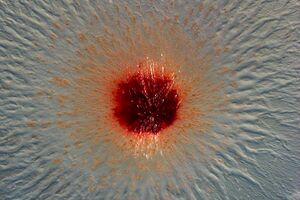Pendulispora rubella
Classification
Bacteria; Myxococcota; Myxococcia; Myxococcales; Sorangiineae; Pendulisporaceae
Species
|
NCBI: [1] |
Pendiluspora rubella (MSr11367)
Description and Significance
P. rubella has a wide range of acid tolerance as it can grow in a pH range of 4-12. This mesophilic organism can thrive in conditions where the temperature range is 18°C-37°C. Unlike other myxobacteria, P. rubella forms a unicellular fruiting body producing powdery round spores and does not form a sporangial coat nor a slime envelope around the spores.
Genome Structure
Pendulispora rubella (MSr11367) has a circular genome with 10,733 total genes. Named GCF_037157805.1-RS_2024_10_26 and fully mapped on 10/26/2024 12:40:18.
Cell Structure, Metabolism and Life Cycle
"Pendulus" meaning 'hanging so as to swing freely or hanging downward' [2] is the prefix for Pendulispora. This is to illustrate the way that P. rubella bears its spores. An advancing swarm colony pattern with flare-like edges, slender rod-shaped vegetative cells, and dormant spores can characterize its growth. P. rubella MSr11367T produces a family of N-terminally acetylated and C-terminally reduced tetrapeptides with an all L-configured amino acid sequence. P. rubella has a unique set of cellular machinery contributing to its metabolism and function. The genes that encode their synthesis mechanics display unparalleled enzymatics. The first ever discovered non-ribosomal peptide synthetase acetylation domain was found within their genome [2]. P. rubella releases rounded spores during spore dispersal that appear powdery.
Ecology and Pathogenesis
Habitat; symbiosis; biogeochemical significance; contributions to environment.
If relevant, how does this organism cause disease? Human, animal, plant hosts? Virulence factors, as well as patient symptoms.
Pendulispora rubella is a soil-living organism
References
Author
Page authored by Colleen Bolmanski, Dakota Lowery, & Beckham LaBarbera, students of Prof. Bradley Tolar at UNC Wilmington.

